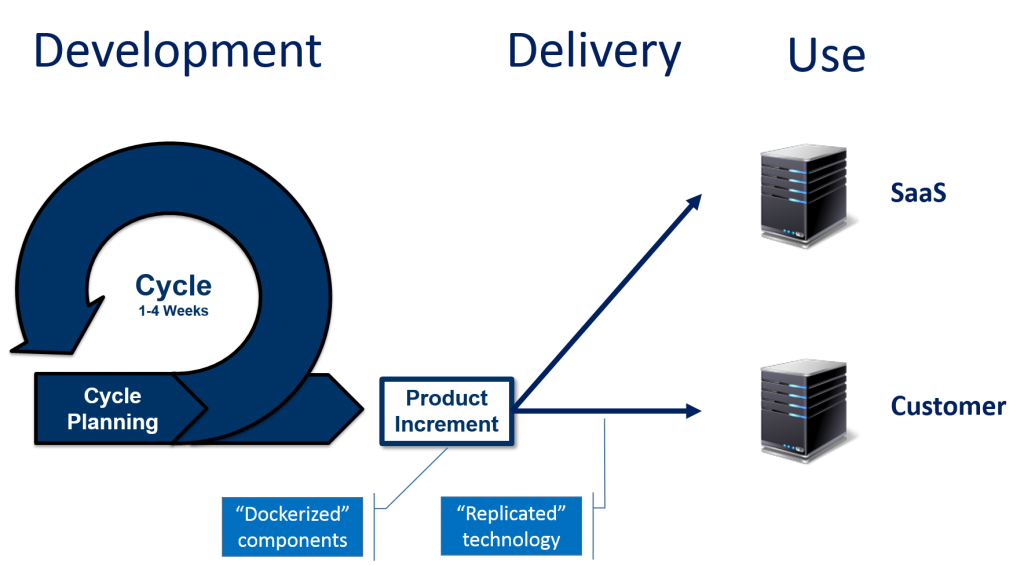Fast delivery of value to customers is today’s business mantra – especially in the software industry. In this blog I reflect on delivery challenges of companies which offer the same product as SaaS AND on-premises solution. I will also present a case study that shows how a company has dramatically improved its on-premises delivery speed.
Within the past 15 years we have seen several approaches how to foster fast delivery of software products. Two prominent ones are:
- Agile development
- Cloud based solutions
The agile approach to software development produces software products incrementally and frequently. This is achieved by close interaction with customers and a set of development principles that are based on the agile manifesto. It is not uncommon that software companies create new versions of their software products on a monthly or even shorter frequency.
How are these product increments delivered to the customer?
Currently there are two major mechanisms in use:
The fastest way for on-premises provisioned products, is to check during launch if there is a newer version of the product available. If so, the newer version will be automatically downloaded and installed. This practice is often used within the software games industry. E.g. games that are provisioned by the steam gaming platform. Traditional ways to deliver a new on-premises version are customer notifications combined with manual on-demand-downloads.
SaaS provisioned products are often under control of the company in charge for the development of the product. Whenever the development organization has produced and tested a new product increment, it will be moved to the SaaS server. Customers that launch the product through their web browser are automatically connected to the latest version of the product. Cloud-based solutions enable software vendors to deliver new software features quite often to their customers. The only thing left to do is to update the software on the runtime environment that is often under their own control. In such environments it is not uncommon that bug fixes and new features are delivered on a weekly or even on a daily basis.
The dual-delivery challenge
Companies which started business after the millennium focus often on cloud based solutions and do not provide on-premises products. In contrast, companies that have been around for more than 15 years are used to on-premises delivery and have established their business around that channel. However, more and more of those companies start to deliver their products as SaaS-based products in addition. Prominent examples are Microsoft with their office suite and HPE with their ALM solution.
Serving two channels with the same product creates new challenges. Customers that utilize on-premises products often have to wait for more than a year to get new features. Features which they can already see within the SaaS version of the same product. This situation creates quite some tension. Therefore, product companies try shortening the delivery cycles for on-premises solutions as well.
The company Jama Software was faced with this challenge and recently came up with a new release model for their on-premises release stream of the requirements product named Jama.
Case study Jama
Jama Software prefers the SaaS delivery channel. However, they accept that some of their customers do not want data managed outside their company’s intranet. Especially, if the data contains sensitive information about upcoming product releases which is usually the case when managing requirements.
As a consequence, Jama Software delivers its product as a hosted solution via SaaS AND as an on-premises solution. Typically, they release two on-premises versions within a year. However, customers using the SaaS version get access to new product features much earlier.
In summer 2016 Jama Software announced a significantly changed new release mechanism: On-premises Express. With the on-premises express channel they aim to deliver new versions on a monthly base. Compared to the half year release schedule so far this represents a stunning acceleration in delivery.
What are the secrets to Jama Software’s cycle time reduction?
First of all: A thorough analysis of the current situation. Finding out the areas of work that need a lot of time for each release. The current server part of the product Jama is delivered on two operating systems: Windows and Linux. All used 3rd party components need to be available on both platforms at the same time. So far Jama Software supports two database systems: MySQL and Oracle. Features and bug-fixes need to be tested on both platforms and DBs. Testing bug fixes and new product features on the various configurations consumes quite some time.
Jama product management made the tough decision to drop support for Microsoft Windows server and Oracle DB. This enabled the QA organization to substantially reduce time for testing. Now Jama Software delivers the same software configuration to their customers that they use on their hosted platform as well.
Second, they analyzed their current architecture in regards to ease of modification. They found out, that they could improve their product significantly by a new way of modularization.
Third, they decided to utilize top-notch technology for isolating the product into distinct independent components, thereby easing software distribution. Jama Software decided to utilize Docker containers. They now encapsulate product dependencies like Java and Tomcat into containers, so that customers don’t need to care about specific Java or Tomcat versions.
Fourth, accelerating deployment. Jama software now uses Replicated. This technology takes advantage of Docker and deploys containers not only to the SaaS server of the vendor but also behind a customer’s firewall. Using Replicated Jama Software now builds the product just once and deploys the result simultaneously to their own hosted instance and to registered customers.
Encapsulating product services into Docker container and managing deployment with Replicated enables Jama Software to manage deployment of the service-oriented architecture much faster, more flexible and more reliable than before.
Summary
Achieving cycle time reduction in development is just one element to deliver software to customers more frequently. It needs to be matched by fast deployment methods, so that the whole DevOps chain can be covered. On top of that the product managers of Jama Software needed to make some tough decisions what not to support in the future. These decisions took complexity out of the product and significantly reduced testing time. Product managers are responsible for the overall product success. They have a holistic view of the business and need to look at all aspects along the delivery chain of a product in order to come up with solutions that enable sustainable business success. Jama Software has rebuild major elements along that line.
We may expect similar moves by other vendors this year as they all face similar pressures.
Stay tuned.
Further information:
Replicated Technology: SaaS vs. on prem solved
Software Product Management: Key to software product success


